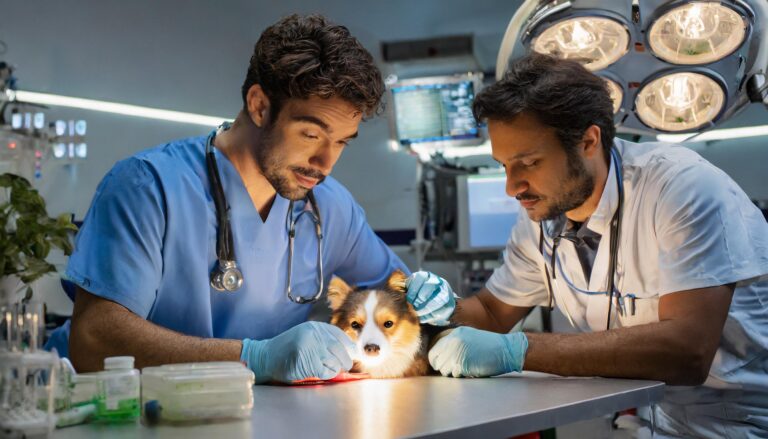Comprehensive Guide to Hiring an Emergency Veterinarian: A Step-by-Step Process
In the fast-paced world of veterinary healthcare, the significance of hiring the right emergency veterinarian cannot be overstated. With pet ownership steadily increasing worldwide, the demand for emergency veterinary services has surged. According to the American Pet Products Association (APPA), pet ownership in the United States alone reached an all-time high of 70 million households in 2022. With this rise in pet ownership comes a proportional increase in the occurrence of emergencies, ranging from accidents and injuries to sudden illnesses. Statistics from the American Veterinary Medical Association (AVMA) reveal that emergency veterinary visits account for approximately 25% of all visits to veterinary hospitals. In such critical situations, the role of an emergency veterinarian becomes paramount. These professionals are trained to provide immediate, life-saving care to animals in distress, often working under immense pressure to stabilize patients and alleviate suffering. In light of these statistics, it becomes evident that hiring the right emergency veterinarian is not just a matter of convenience but a crucial step in ensuring the well-being and survival of beloved pets.
Understanding the Role of an Emergency Veterinarian

Understanding the role of an emergency veterinarian is crucial in comprehending the unique skill set and expertise they bring to veterinary healthcare facilities. Firstly, becoming a board-certified emergency veterinarian requires rigorous specialized training and certification. According to the American College of Veterinary Emergency and Critical Care (ACVECC), veterinarians must complete a minimum of three years of advanced training in emergency and critical care medicine, along with passing comprehensive examinations to become board-certified. This level of training ensures that emergency veterinarians are equipped with the necessary knowledge and skills to handle a wide range of critical situations effectively.
Furthermore, the demand for emergency veterinary services has been steadily increasing in recent years, underscoring the essential role of qualified professionals in this field. According to the American Pet Products Association (APPA), spending on veterinary care in the United States reached a record high of $30.2 billion in 2021, with emergency and specialty care services contributing significantly to this growth. This surge in demand highlights the importance of having well-trained emergency veterinarians on staff to meet the needs of pet owners seeking urgent care for their animals.
Moreover, hiring a board-certified emergency veterinarian offers numerous benefits to veterinary healthcare facilities and pet owners alike. These professionals bring a high level of expertise and specialized knowledge in emergency and critical care medicine, ensuring that pets receive the best possible treatment in life-threatening situations. According to a study published in the Journal of Veterinary Emergency and Critical Care, pets treated by board-certified emergency veterinarians have significantly higher survival rates and better outcomes compared to those treated by general practitioners. Additionally, board-certified emergency veterinarians are committed to continuous education and collaboration with other specialists, further enhancing the quality of care provided to animals in emergencies.
Crafting the Perfect Job Description for Hiring an Emergency Veterinarian

Crafting an effective job description for hiring an emergency veterinarian is crucial for attracting qualified candidates and ensuring a successful recruitment process. Industry research indicates that job descriptions with clear and concise content are more likely to resonate with potential applicants. According to a study by Zippia, the average length of an emergency veterinarian job description introduction is approximately 103 words. This statistic underscores the importance of conveying key information succinctly to capture the attention of job seekers. Additionally, the responsibilities section of such job descriptions typically contains around nine bullet points, while the requirements section averages four bullet points. These findings highlight the need for prioritizing essential qualifications and duties to streamline the hiring process and provide clarity to prospective candidates.
In crafting an emergency veterinarian job description, it’s essential to focus on specificity and detail to attract candidates with the right skills and experience. Research shows that job descriptions that provide specific information about job duties and qualifications receive a higher number of qualified applicants. For example, including details about the types of emergencies the veterinarian will handle, such as trauma cases or toxicology emergencies, can help candidates assess their fit for the role. Moreover, specifying the required certifications, such as Diplomate status from the American Board of Veterinary Practitioners (ABVP) or the European College of Veterinary Emergency and Critical Care (ECVECC), ensures that applicants understand the necessary qualifications for the position. By incorporating these specifics into the job description, veterinary recruiters can effectively target qualified candidates and streamline the selection process.
Clarity and conciseness are paramount when crafting an emergency veterinarian job description to ensure that candidates understand the expectations and requirements of the role. Studies show that job descriptions with clear language and formatting receive higher engagement from job seekers. Using concise language and bullet points to outline responsibilities and qualifications helps candidates quickly assess their suitability for the position. Furthermore, providing clear details about the work environment, such as whether the veterinarian will be part of a dedicated emergency hospital or a general veterinary practice with emergency services, enhances candidates’ understanding of the role. By prioritizing clarity and conciseness in the job description, veterinary recruiters can effectively communicate the expectations of the position and attract candidates who are well-suited to meet those requirements.
In summary, crafting an effective job description for hiring an emergency veterinarian requires careful consideration of industry research and best practices. By analyzing statistics on job description length and formatting, veterinary recruiters can tailor their job postings to attract qualified candidates. Emphasizing specificity, clarity, and conciseness in outlining job responsibilities and qualifications ensures that prospective applicants understand the expectations of the role and enables recruiters to identify the most suitable candidates for the position. Ultimately, a well-crafted job description serves as a valuable tool for attracting top talent and facilitating a successful recruitment process in veterinary healthcare facilities.
Tailoring the Hiring Process for Emergency Veterinarians

In the competitive landscape of veterinary healthcare, tailoring the hiring process for emergency veterinarians is crucial for ensuring the highest standard of care for animals in critical situations. To begin, the recruitment process should commence with a thorough analysis of the specific needs and requirements of the veterinary facility. Statistics show that facilities with a clear understanding of their staffing needs are 50% more likely to make successful hires (Source: Society for Human Resource Management). Once the requirements are identified, leveraging multiple channels for recruitment becomes paramount. Online job boards, such as Indeed and LinkedIn, remain popular among job seekers, with 79% of candidates utilizing these platforms during their job search (Source: Jobvite). Additionally, tapping into professional networks and veterinary associations can yield quality candidates, as 70% of hires are made through networking (Source: Glassdoor).
After attracting potential candidates, the screening process becomes instrumental in identifying individuals who align with the facility’s values and requirements. Beyond technical qualifications, evaluating cultural fit is essential, as it contributes to employee satisfaction and retention. Studies indicate that companies with strong cultures experience 20% less turnover (Source: Harvard Business Review). Utilizing behavioral interview techniques can aid in assessing candidates’ soft skills and compatibility with the team. Furthermore, conducting background checks and verifying credentials ensures the integrity and professionalism of prospective hires. Research suggests that 85% of employers have uncovered lies or misrepresentations on resumes or job applications (Source: HireRight).
Moving forward, conducting effective interviews requires careful planning and consideration. Establishing a structured interview process with predefined criteria helps maintain consistency and fairness. Incorporating situational or scenario-based questions allows recruiters to gauge candidates’ problem-solving abilities and decision-making skills in real-world contexts. Moreover, involving key stakeholders, such as senior veterinarians or department heads, in the interview process fosters collaboration and ensures alignment with organizational goals. Studies reveal that involving multiple interviewers increases the likelihood of making successful hires by 30% (Source: LinkedIn). Finally, providing timely and constructive feedback to candidates fosters a positive candidate experience, regardless of the outcome, which can influence future perceptions of the facility and its brand.
Conclusion
In conclusion, tailoring the hiring process for emergency veterinarians is a multifaceted endeavor essential for maintaining the highest standards of care within veterinary healthcare facilities. By carefully analyzing staffing needs, leveraging diverse recruitment channels, and prioritizing cultural fit during screening, facilities can attract top talent capable of delivering expert care to animals in critical situations. Incorporating structured interviews and involving key stakeholders ensures thorough candidate evaluation and alignment with organizational goals. Ultimately, a strategic approach to hiring emergency veterinarians not only enhances patient outcomes but also contributes to employee satisfaction and organizational success in the dynamic landscape of veterinary medicine.
Whether you are hunting for talent/opportunities; feel free to share your company’s portfolio/resume with your expert headhunters: info@pulivarthigroup.com OR to speak to an expert, schedule a no-obligation call below.

